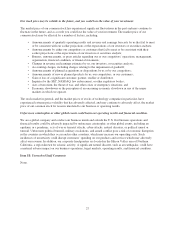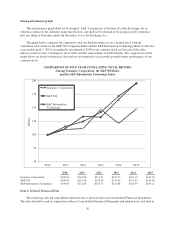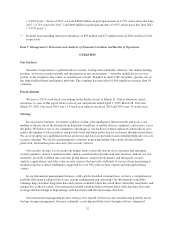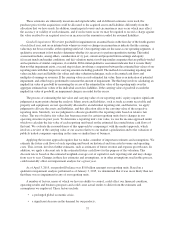Symantec 2015 Annual Report Download - page 115
Download and view the complete annual report
Please find page 115 of the 2015 Symantec annual report below. You can navigate through the pages in the report by either clicking on the pages listed below, or by using the keyword search tool below to find specific information within the annual report.These estimates are inherently uncertain and unpredictable, and if different estimates were used, the
purchase price for the acquisition could be allocated to the acquired assets and liabilities differently from the
allocation that we have made. In addition, unanticipated events and circumstances may occur which may affect
the accuracy or validity of such estimates, and if such events occur we may be required to record a charge against
the value ascribed to an acquired asset or an increase in the amounts recorded for assumed liabilities.
Goodwill impairment. We review goodwill for impairment on an annual basis on the first day of the fourth quarter
of each fiscal year, and on an interim basis whenever events or changes in circumstances indicate that the carrying
value may not be recoverable, at the reporting unit level. Our reporting units are the same as our operating segments. A
qualitative assessment is first made to determine whether it is necessary to perform quantitative testing. This initial
assessment includes, among others, consideration of: (i) past, current and projected future earnings and equity;
(ii) recent trends and market conditions; and (iii) valuation metrics involving similar companies that are publicly-traded
and acquisitions of similar companies, if available. If this initial qualitative assessment indicates that it is more likely
than not that impairment exists, a second step is taken, involving a comparison between the estimated fair values of our
reporting units with their respective carrying amounts including goodwill. The methods for estimating reporting unit
values include asset and liability fair values and other valuation techniques, such as discounted cash flows and
multiples of earnings or revenues. If the carrying value exceeds estimated fair value, there is an indication of potential
impairment, and a third step is performed to measure the amount of impairment. The third step involves calculating an
implied fair value of goodwill by measuring the excess of the estimated fair value of the reporting units over the
aggregate estimated fair values of the individual assets less liabilities. If the carrying value of goodwill exceeds the
implied fair value of goodwill, an impairment charge is recorded for the excess.
The process of estimating the fair value and carrying value of our reporting units’ equity requires significant
judgment at many points during the analysis. Many assets and liabilities, such as trade accounts receivable and
property and equipment, are not specifically allocated to an individual reporting unit, and therefore, we apply
judgment to allocate the assets and liabilities, and this allocation affects the carrying value of the respective
reporting units. Similarly, we use judgment to allocate goodwill to the reporting units based on relative fair
values. The use of relative fair values has been necessary for certain reporting units due to changes in our
operating structure in prior years. To determine a reporting unit’s fair value, we use the income approach under
which we calculate the fair value of each reporting unit based on the estimated discounted future cash flows of
that unit. We evaluate the reasonableness of this approach by comparing it with the market approach, which
involves a review of the carrying value of our assets relative to our market capitalization and to the valuation of
publicly traded companies operating in the same or similar lines of business.
Applying the income approach requires that we make a number of important estimates and assumptions. We
estimate the future cash flows of each reporting unit based on historical and forecasted revenue and operating
costs. This, in turn, involves further estimates, such as estimates of future revenue and expense growth rates. In
addition, we apply a discount rate to the estimated future cash flows for the purpose of the valuation. This
discount rate is based on the estimated weighted-average cost of capital for each reporting unit and may change
from year to year. Changes in these key estimates and assumptions, or in other assumptions used in this process,
could materially affect our impairment analysis for a given year.
As of April 3, 2015, our goodwill balance was $5.8 billion amongst our reporting units. Based on a
qualitative impairment analysis performed as of January 3, 2015, we determined that it was more likely than not
that there was no impairment in any of our reporting units.
A number of factors, many of which we have no ability to control, could affect our financial condition,
operating results and business prospects and could cause actual results to differ from the estimates and
assumptions we employed. These factors include:
• a prolonged global economic crisis;
• a significant decrease in the demand for our products;
37
























